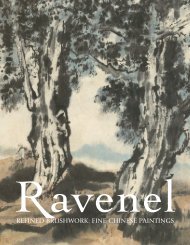亞洲現代與當代藝術 Modern and Contemporary Asian Art
羅芙奧2018春季拍賣會 亞洲現代與當代藝術 Ravenel Spring Auction 2018 Modern and Contemporary Asian Art
羅芙奧2018春季拍賣會 亞洲現代與當代藝術 Ravenel Spring Auction 2018 Modern and Contemporary Asian Art
Create successful ePaper yourself
Turn your PDF publications into a flip-book with our unique Google optimized e-Paper software.
“My art originates from hallucinations only I can see, I translate the hallucinations<br />
<strong>and</strong> obsessional images that plague me into sculptures <strong>and</strong> paintings.”<br />
- Yayoi KUSAMA<br />
As the most influential female artist within the <strong>Asian</strong> contemporary<br />
art scene, Yayoi Kusama’s status on the international art stage<br />
cannot be ignored. Her works minutely <strong>and</strong> truthfully bear the<br />
weight of her past, <strong>and</strong> of nightmares she cannot rid. Kusama<br />
makes use of painting, sculpture, performance art, <strong>and</strong> other<br />
techniques to represent the universe residing in her mind from a<br />
surreal psychological perspective. Her highly saturated contrasting<br />
colors has left a mark on the visual arts, music, <strong>and</strong> fashion.<br />
Revealing an unconcealed soul, she is herself an “idol”.<br />
Having shown artistic talent since childhood, she studied nihonga,<br />
pastel, <strong>and</strong> other traditional Japanese painting techniques in her<br />
hometown. In 1957, encouraged by the American artist Georgia<br />
O’Keeffe, she moved to New York, where she learnt the value<br />
of creative freedom. Kusama’s work is very diverse, including<br />
paintings, soft sculptures, performance art, installations, videos.<br />
It covers movements, such as pop art, feminism, surrealism, <strong>Art</strong><br />
Brut, expressionism, <strong>and</strong> Happening <strong>Art</strong>. In 1993 she represented<br />
Japan at the 45th Venice Biennale. From then on, her pumpkinthemed<br />
works became famous, leading to the creation of largescale<br />
installations, such as the outdoor sculpture at Fukuoka <strong>Art</strong><br />
Museum. Inspiration for the “pumpkin” theme originated from the<br />
artist’s childhood. During the war, Kusama’s home was filled with<br />
pumpkins. She said, “When I was a child I used to play in the plant<br />
nursery outside my house. The pumpkins I picked would talk to me.<br />
The shape of a pumpkin is way too cute…what attracts me is its<br />
bare swollen belly, <strong>and</strong> the strong sense of mental stability”.<br />
Through continuous production of a great number of artworks, a life<br />
of pain is turned into a peaceful beauty. Kusama’s paintings reveal<br />
her unique way of thinking <strong>and</strong> autobiographical connotations.<br />
When she picks up the brush, she gets in contact with a mysterious<br />
world through fortuitous <strong>and</strong> unpredictable motives. Her inner<br />
strength <strong>and</strong> subconscious thoughts display a vast universe. An<br />
endless passion for painting <strong>and</strong> a religious reverence towards art<br />
have helped her battle mental illness for a long time. Kusama uses<br />
art to heal her wounds. Therefore, all her works are an expression of<br />
her deepest feelings. Similar to many of her other works, Pumpkin<br />
gathers the visual elements of each of her series <strong>and</strong> presents the<br />
hallucinations that trouble the artist. Using big <strong>and</strong> small black dots,<br />
Kusama arranges the shape of her pumpkin, making the bright<br />
yellow surface st<strong>and</strong> out, <strong>and</strong> creating a contrast that brings about<br />
a great visual shock. The yellow lines in the background form an<br />
“infinity net”, which highlights the pumpkin’s plump figure <strong>and</strong><br />
reflects her endlessly growing artistic vitality. Kusama’s painting<br />
does not fall into being just a compositional pattern. Instead, she<br />
portrays objects as particles, which aggregate <strong>and</strong> then dissipate<br />
into dots <strong>and</strong> lines. The center of the so-called picture is completely<br />
untraceable. This entirely overwhelming practice matches with<br />
the style of Jackson Pollock, the master of American abstract<br />
expressionism. Emphasizing the material factors involved in the<br />
act of painting is also an extreme manifestation of the infinite. This<br />
painting is the direct record of a behavior dominated by emotions,<br />
<strong>and</strong> of that freestyle filled with rhythm which characterizes her<br />
painting process.







